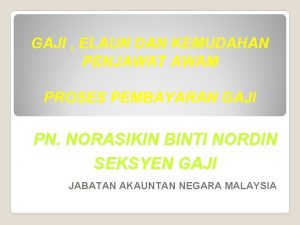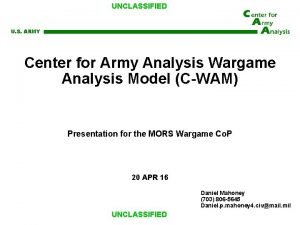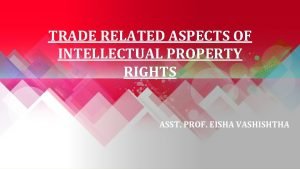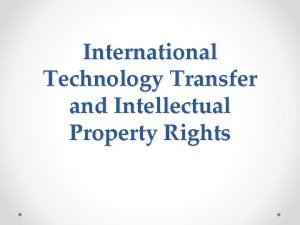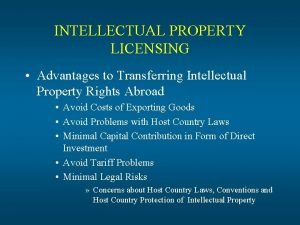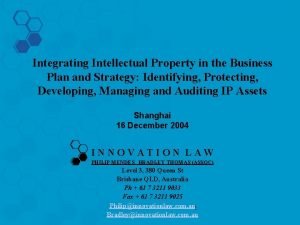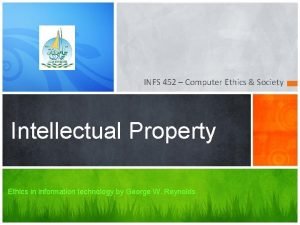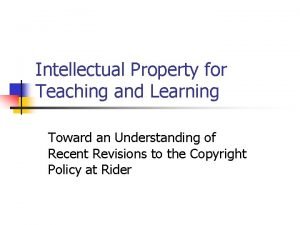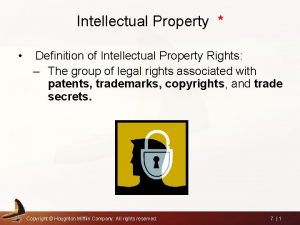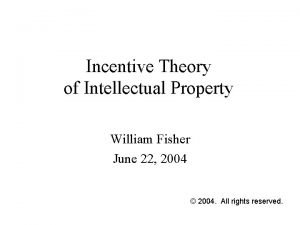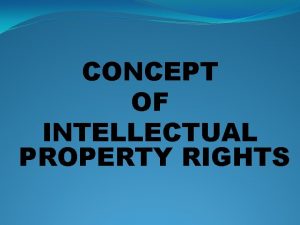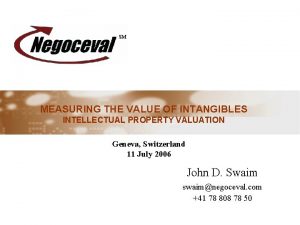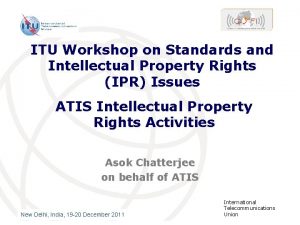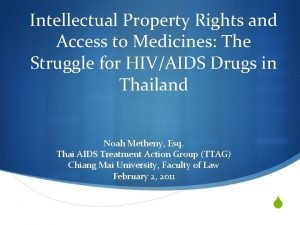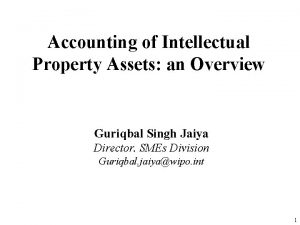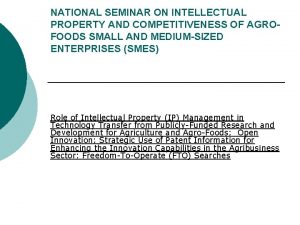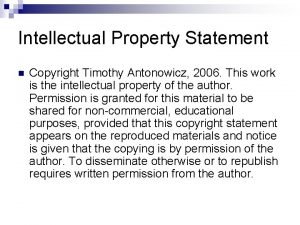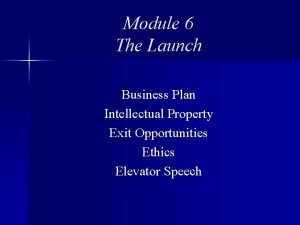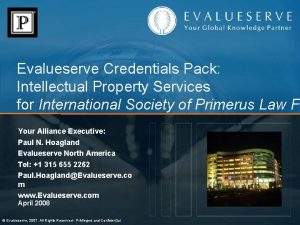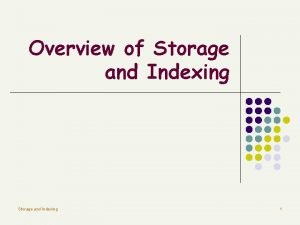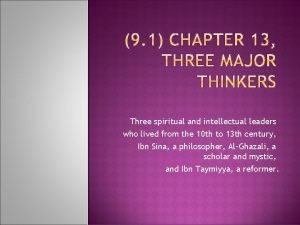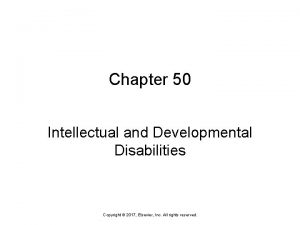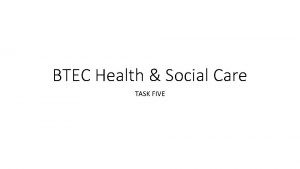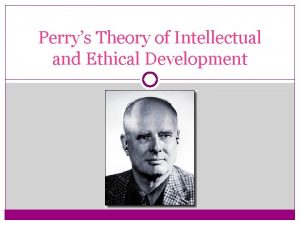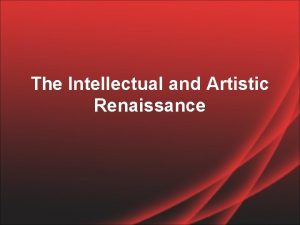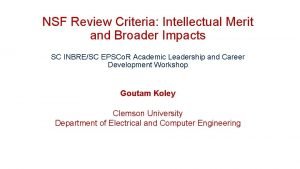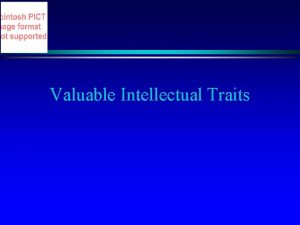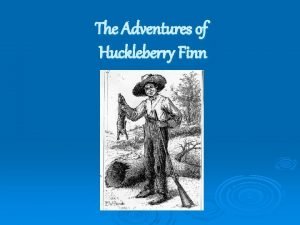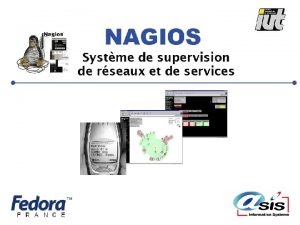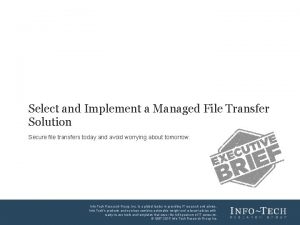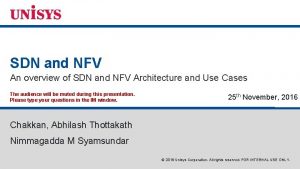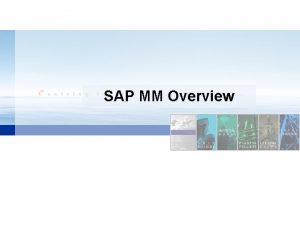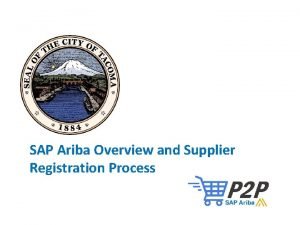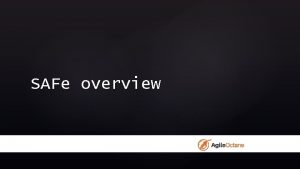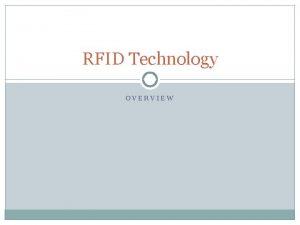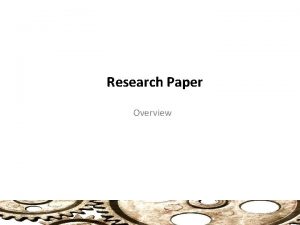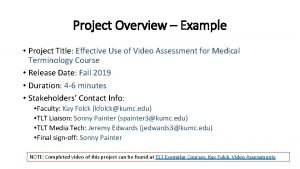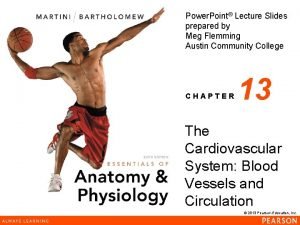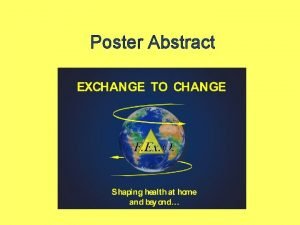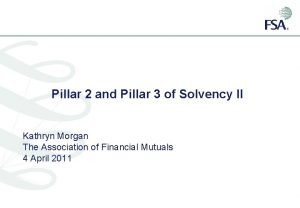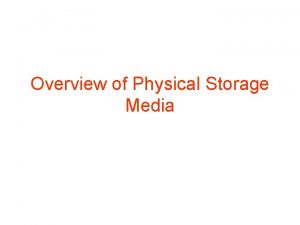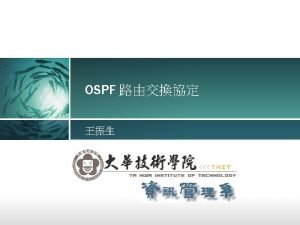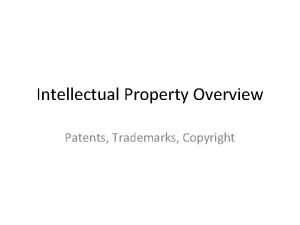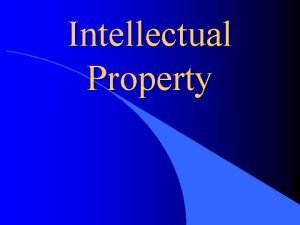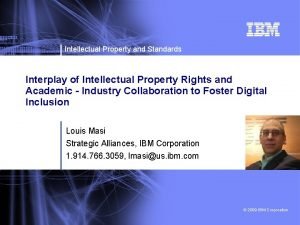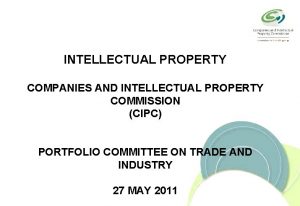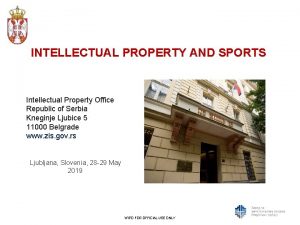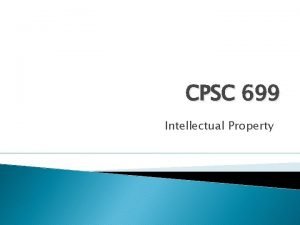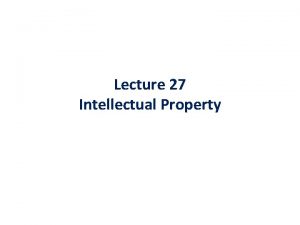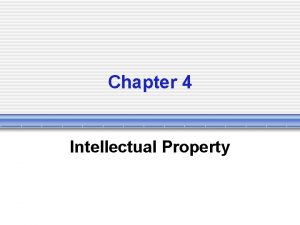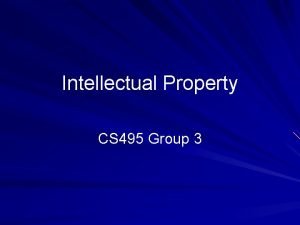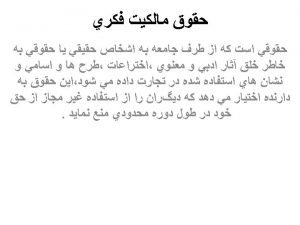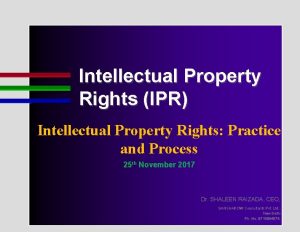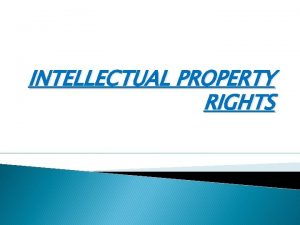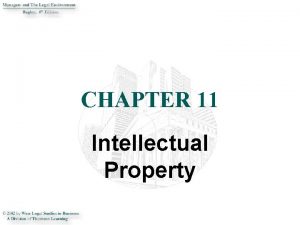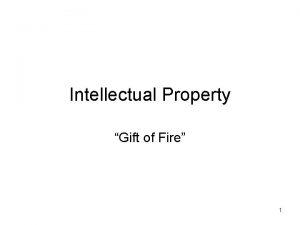Intellectual Property CS 4020 Overview Intellectual Property and











































































- Slides: 75

Intellectual Property CS 4020

Overview • Intellectual Property and Changing Technology • Principles, Laws and Cases: Copyright Law and Significant Cases • Search Engines and Online Libraries • Software – free, open source, proprietary • Patents for Inventions in Software & Issues for Software Developers

What is Intellectual Property? • Deals in part with intangible creative work, not its particular physical form • Value of intelligence and artistic work comes from creativity, ideas, research, skills, labor, non-material efforts and attributes the creator provides • Protected by copyright and patent law

Copyright holders have exclusive rights (title 17 of U. S. Code) • To make copies • To produce derivative works, such as translations into other languages or movies based on books • To distribute copies • To perform the work in public (e. g. music, plays) • To display the work in public (e. g. artwork, movies, computer games, video on a Web site)

Ethics and Copying • Unlike physical property, copying or distributing a song, video, or computer program does not decrease the use or enjoyment by another person • Copying can decrease the economic value of creative work produced for sale • The fair use guidelines are useful ethical guidelines • There are many arguments for and against unauthorized copying

Challenges of New Technology • Digital technology and the internet has made copyright infringement easier and cheaper • New compression technologies have made copying large files (e. g. graphics, video and audio files) feasible • Search engines make finding material easier. • Peer-to-peer technology makes transferring and sharing files easier.

MORE Challenges of New Technology • Broadband connections make transferring files easier and enable streaming video. • Miniaturization of cameras and other equipment enable audience members to record and transmit events. • Scanners allow us to change the media of a copyrighted work, converting printed text, photos, and artwork to electronic form. • New tools allow us to modify graphics, video and audio files to make derivative works

Different perspectives

Discussion Questions • IP. 1) How is intellectual property like physical property? • IP. 2) How is intellectual property different than physical property? • IP. 3) Do you agree with the idea that someone can "own" intellectual property? • Post your answers to Blackboard

COPYRIGHT LAW A LITTLE HISTORY

Copyright Law and Significant Cases A bit of history: • 1790 first copyright law passed • 1909 Copyright Act of 1909 defined an unauthorized copy as a form that could be seen and read visually • 1976 and 1980 copyright law revised to include software and databases that exhibit "authorship" (original expression of ideas), included the "Fair Use Doctrine" • 1982 high-volume copying became a felony • 1992 making multiple copies for commercial advantage and private gain became a felony

Copyright Law and Significant Cases (cont. ) • 1997 No Electronic Theft Act made it a felony to willfully infringe copyright by reproducing or distributing one or more copies of copyrighted work with a total value of more than $1, 000 within a sixmonth period • 1998 Digital Millennium Copyright Act (DMCA) prohibits making, distributing or using tools to circumvent technological copyright protection systems and included protection from some copyright lawsuits for Web sites where users post material • 2005 Congress made it a felony to record a movie in a movie theater

THE FAIR USE DOCTRINE

Fair Use Doctrine • Fair use is a doctrine in United States copyright law that allows limited use of copyrighted material without requiring permission from the rights holders, such as use for scholarship or review. It provides for the legal, non-licensed citation or incorporation of copyrighted material in another author's work under a four-factor balancing test. Four factors considered 1. Purpose and nature of use – commercial (less likely) or non-profit purposes 2. Nature of the copyrighted work 3. Amount of significance or portion used 4. Effect of use on potential market or value of the copyright work (will it reduce sales of work? ) – No single factor alone determines – Not all factors given equal weight, varies by circumstance

A FEW FAMOUS CASES

CASE: Sony v. Universal City Studios (1984) – Supreme Court decided that the makers of a device with legitimate uses should not be penalized because some people may use it to infringe on copyright – Supreme Court decided copying movies for later viewing was fair use – Arguments against fair use • People copied the entire work • Movies are creative, not factual

Continued---Sony v. Universal City Studios (1984) Arguments for fair use • The copy was for private, noncommercial use and generally was not kept after viewing • The movie studios could not demonstrate that they suffered any harm • The studios had received a substantial fee for broadcasting movies on TV, and the fee depends on having a large audience who view for free

CASE: Reverse engineering game machines • Sega Enterprises Ltd. v. Accolade Inc. (1992) • Atari Games v. Nintendo (1992) • Sony Computer Entertainment, Inc. v. Connectix Corporation (2000) • Courts ruled that reverse engineering does not violate copyright if the intention is to make new creative works (video games), not copy the original work (the game systems)

CASE: Sharing music: the Napster case • Was the sharing of music via Napster fair use? • Napster's arguments for fair use – The Sony decision allowed for entertainment use to be considered fair use – Did not hurt industry sales because users sampled the music on Napster and bought the CD if they liked it • RIAA's (Recording Industry Association of America) arguments against fair use – "Personal" meant very limited use, not trading with thousands of strangers – Songs and music are creative works and users were copying whole songs – Claimed Napster severely hurt sales • Court ruled sharing music via copied MP 3 files violated copyright

CASE: Napster continued… • Was Napster responsible for the actions of its users? • Napster's arguments – It was the same as a search engine, which is protected under the DMCA – They did not store any of the MP 3 files – Their technology had substantial legitimate uses

CASE: Napster continued… • RIAA's arguments – Companies are required to make an effort to prevent copyright violations and Napster did not take sufficient steps – Napster was not a device or new technology and the RIAA was not seeking to ban the technology • Court ruled Napster liable because they had the right and ability to supervise the system, including copyright infringing activities

CASE: File sharing - MGM v. Grokster • Grokster, Gnutella, Morpheus, Kazaa, and others provided peer-to-peer (P 2 P) file sharing services – The companies did not provide a central service or lists of songs – P 2 P file transfer programs have legitimate uses • Lower Courts ruled that P 2 P does have legitimate uses • REVISED Supreme Court ruled that intellectual property owners could sue the companies for encouraging copyright infringement

Discussion Question • IP. 4) What do you think the impact would be on creative industries, such as music, movies and fiction novels, if copyright laws did not protect their intellectual property? • Post your answer on Discussion Board.

…some solutions and responses from industry PROTECTING AGAINST COPYING

Solutions to protect against Software Copying and Sharing • Expiration dates within the software, after which it will not function • Dongles (a device that must be plugged into a computer port) – software will not start without this check for hardware. • Copy protection that prevents copying • Activation or registration codes –SW wont start/install without this • In case of sites posting/providing access illegally to software -Obtain court orders to shut down

Techniques to prevent content stealing. • Banning, suing and taxing – Ban or delay technology via lawsuits. Here they are trying to prevent the availability of new technology that enables copying. Examples: • CD-recording devices • Digital Audio Tapes (DAT) • DVD players • Portable MP 3 players – Require that new technology include copyright protections – Tax digital media to compensate the industry for expected losses (make consumers pay for theft).

Digital Rights Management • Collection of techniques that control uses of intellectual property in digital formats • Includes hardware and software schemes using encryption • The producer of a file has flexibility to specify what a user may do with it • Apple, Microsoft and Sony all use different schemes of DRM

Protection versus innovation • Lawsuits have been filed to ban new technologies • U. S. courts have banned technologies such as De. CSS even though it has legitimate uses, while courts in other countries have not. – De. CSS is a computer program capable of decrypting content on a DVD-Video disc encrypted using the Content-Scrambling System (CSS). • Protesters published the code as part of creative works (in haiku, songs, short movies, a computer game and art) • U. S. courts eventually allowed publishing of De. CSS, but prohibited manufacturers of DVD players from including it in their products

The DMCA 1998 • The Digital Millennium Copyright Act (DMCA) is a United States copyright law which implements two 1996 WIPO treaties. It criminalizes production and dissemination of technology, devices, or services that are used to circumvent measures that control access to copyrighted works (commonly known as DRM) and criminalizes the act of circumventing an access control, even when there is no infringement of copyright itself. It also heightens the penalties for copyright infringement on the Internet. • The DMCA has been criticized for making it too easy for copyright owners to encourage website owners to take down infringing content and links when it may not in fact be infringing. When website owners receive a takedown it may be easier to comply, even if it is not clear if infringement is taking place, because if the potentially infringing content is taken down the website will not be held liable. Anticircumvention Prohibit circumventing technological access controls and copy-prevention systems Safe harbor Protect Web sites from lawsuits for copyright infringement by users of site

DMCA & Safe Harbor • Industry issues "take down" notices per the DMCA • As long as sites like You. Tube and My. Space comply with take down notices they are not in violation • Take down notices may violate fair use, some have been issued against small portions of video being used for educational purposes

DMCA versus fair Use, Freedom of Speech and Innovation • Lawsuits have been filed to ban new technologies • U. S. courts have banned technologies such as De. CSS even though it has legitimate uses, while courts in other countries have not. • Protesters published the code as part of creative works (in haiku, songs, short movies, a computer game and art) • U. S. courts eventually allowed publishing of De. CSS, but prohibited manufacturers of DVD players from including it in their products Smartphones, tablets, game machines, and other devices have mechanisms to prevent installation of software or use of services that the maker of the device does not support or approve. Cracking such mechanisms is sometimes called jailbreaking, unlocking, or rooting.

Video Sharing – Conflict & Solutions. • Industry issues "take down" notices per the DMCA • As long as sites like You. Tube, Facebook , etc. comply with take down notices they are not in violation • Take down notices may violate fair use, some have been issued against small portions of video being used for educational purposes

New Business Models and Constructive Solutions • Organizations set up to collect and distribute royalty fees (e. g. the Copyright Clearance Center), users don't have to search out individual copyright holders • Sites such as i. Tunes and the new Napster provide legal means for obtaining inexpensive music and generate revenue for the industry and artists • Revenue sharing allows content-sharing sites to allow the posting of content and share their ad revenues with content owners in compensation

More new business models • The industry imbeds advertising in files that it then posts to the P 2 P sites, the advertiser gets its message out and the industry gets its fees • Fan fiction is generally not seen as a threat, the writers are also the customers for the original works

Some examples of businesses shut down for their business models – Zediva, a small startup in 2011, bought DVDs and rented the content (not the physical DVD) to customers legally. Court ordered Zediva to shut down. – Pirate Bay – Megaupload

Cloud storage raises copyright issues. – Is copying legally purchased files to and from the cloud a fair use? – Will the companies operating the cloud services have any responsibility for unauthorized content their customers store and share? – Since copyright holders do not see what is stored, they do not have the option of sending takedown notices.

Discussion Question • IP. 5) Some have argued that copyright lawsuits have been used to stifle innovation, do you agree? Why or why not? • Post your answer on Discussion Board.

…a business problem INTERNATIONAL PIRACY

International Piracy • Some countries do not recognize or protect intellectual property • Countries that have high piracy rates often do not have a significant software industry • Many countries that have a high amount of piracy are exporting the pirated copies to countries with strict copyright laws • Economic sanctions often penalize legitimate businesses, not those they seek to target

…. who is responsible SEARCH ENGINES

Search Engines and Online Libraries. . what are the issues? • Caching and displaying small excerpts is fair use • Creating and displaying thumbnail images is fair use • Example - Court ordered Google to remove links to pages that infringe copyright; • Google negotiated licensing agreements with news services to copy and display headlines, excerpts, and photos

Online Books – Project Guttenberg digitizes books in the public domain – Microsoft scanned millions of public domain books in University of California's library – Google has scanned millions of books that are in the public domain and that are not; they display only excerpts from those still copyrighted

…when they conflict COPYRIGHT AND FREE SPEECH

Domain Names and Political Statements • Domain names may be used to criticize or protest (e. g. XYZIs. Junk. org) • Companies sue under trademark violation, but most cases dismissed • Some companies buy numerous domain names containing their name so others cannot use them

Posting of Documents for Criticism • Documents that are copyrighted and trade secrets have been posted as a form of criticism • Organizations have sued to have the documents removed from the Web • In some cases courts have ruled that it is a copyright violation and the documents must be removed • In one judgment against the Church of Scientology, the court ruled that the church’s primary motivation was "to stifle criticism of Scientology in general and to harass its critics"

COPYRIGHT AND SOFTWARE LICENSING. . who uses software, how use it, how/if extend it, sub-licensing, credit/authorship and more

Free Software Should All Software Be Free? • Would there be sufficient incentives to produce the huge quantity of consumer software available now? • Would the current funding methods for free software be sufficient to support all software development? • Should software be covered under copyright law? • Concepts such as copyleft and the GNU Public License provide alternatives to proprietary software within today's current legal framework I want to be paid!

Range of Software Licenses • Public Domain • “non-protective”/permissive FOSS License – Example BSD License, MIT License • Protective FOSS License – Example GNU GPL • Proprietary License – Example corporate developed licenses

Proprietary Software is computer software for which the software's publisher or another person retains intellectual property rights— copyright of the source code & sometimes patent rights. • • • Most restrictive Often includes no copy, no redistribution, no extension Developed by each corporation Example – Microsoft Office, Mac OS, etc. Often distributed in compiled form (not source)

Proprietary Software & End-User License Agreement • The user may agree to this contract in writing, interactively on screen (clickwrap), or by opening the box containing the software (shrink wrap licensing).

Proprietary Software & Patents • Will cover Patents later • grant exclusive rights to algorithms, software features, or other patentable subject matter, with coverage varying by jurisdiction

GNU General Public License http: //www. gnu. org User may not charge for software, may not place additional restrictions on license • Began with a UNIX-like operating system, a sophisticated text editor, and many compilers and utilities • Now has hundreds of programs freely available and thousands of software packages available as free software (with modifiable source code) • Developed the concept of copyleft Free software has many advantages. With freely distributed software, more people can use and benefit from a program. With source code available, any of thousands of programmers can find and fix bugs quickly. Users and programmers can adapt and improve programs. Under copyleft, the developer copyrights the program and releases it under an agreement that allows people to use, modify, and distribute it, or any program developed from it, but only if they apply the same agreement to the new work. No one may develop a new program from a copylefted program and add restrictions that limit is use and free distribution. Courts have said a person can sue for an injunction against someone who uses copylefted software without following the open source licensing agreement.

FOSS Licenses • Free and open-source software (FOSS) is software that can be classified as both free software and open-source software – FOSS Permissive (non-protective) • Example BSD – FOSS Non-Protective • Example GNU GPL

Permissive free FOSS software licenses – example BSD License • imposing minimal restrictions on the use and redistribution of covered software. • in contrast to copyleft licenses, which have reciprocity share-alike requirements. BSD = comes from Berkeley Software Distribution which is a Unix like OS.

BSD-old BSD – 1 st version had 4 clauses Redistribution and use in source and binary forms, with or without modification, are permitted provided that the following conditions are met: 1. Redistributions of source code must retain the above copyright notice, this list of conditions and the following disclaimer. 2. Redistributions in binary form must reproduce the above copyright notice, this list of conditions and the following disclaimer in the documentation and/or other materials provided with the distribution. “Advertising Clause” 3. All advertising materials mentioning features or use of this software must display the following acknowledgement: This product includes software developed by the <organization>. “Non-endorsment Clause” 4. Neither the name of the <organization> nor the names of its contributors may be used to endorse or promote products derived from this software without specific prior written permission.

BSD-new BSD – objection to 3 rd “advertising” clause • This clause eventually became controversial, as it required authors of all works deriving from a BSD-licensed work to include an acknowledgment of the original source in all advertising material. • was removed from the license text in the official BSD on 22 July 1999 by William Hoskins, Director of the Office of Technology Licensing for UC Berkeley.

Free. BSD (2 clauses only) • 1999, Omits both #3(“advertising clause) and #4 (nonendorsement clause) • Redistribution and use in source and binary forms, with or without modification, are permitted provided that the following conditions are met: 1. Redistributions of source code must retain the above copyright notice, this list of conditions and the following disclaimer. 2. Redistributions in binary form must reproduce the above copyright notice, this list of conditions and the following disclaimer in the documentation and/or other materials provided with the distribution.

BSD versus GNU GPL • BSD less restrictive • Free. BSD even easier to use for companies who want to make their resulting Software (that may use some Free. BSD software as part of it) proprietary

Public Domain Software • absolutely no ownership such as copyright, trademark, or patent. • can be modified, distributed, or sold even without any attribution by anyone

HOWEVER… Berne Convention – Signed by most countries (though is it enforced) “author automatically obtains the exclusive copyright to anything they have written, and local law may similarly grant copyright, patent, or trademark rights by default. ” – Software is protected by it

Wikipedia’s comparison of Software Licenses NOTE: Right to perform = demonstrate in public

What is Open Source • Open source - software distributed or made public in source code (readable and modifiable) • THIS IS NOT the same thing as license necessarily –different Open Source projects can use different licenses like BSD or GNU GPL I think of Open Source as yes generally free to use code but, as important is that a GROUP project has source that is open and can be worked on collectively

Companies love Open Source for some parts of their business strategy • Typically Free for use • Can influence/sponsor development • May choose to make their software Open Source to get “FREE development on software/tools they need” – Swift for i. OS dev. went Open Source – Android thinking to replace Java with Swift –no more fees

Open Source Initiative • Non-profit promoting open-source code • 1998 founded • Published = The Open Source Definition how to determine whether a software license can be labeled with the opensource certification mark. GO TO https: //en. wikipedia. org/wiki/The_Open_Source_Definition TO READ MORE

Lots of Open Source Projects • • Apache has many Android is open source Many, many more Google likes future employees to be part of Open Source, post Open Source code on your github. com account

A few logos of Open Source SW –too many to list

…. . protecting use of software further…. . SOFTWARE PATENTS

Patents for Software • Patents protect inventions of new things or processes • The Supreme Court said that software could not be patented; however a machine that included software could • Patents are not supposed to be given for things that are obvious or are already in common use • The Patent Office has made mistakes

Some forms of software can be patented • The invention must be novel or confers a new solution to a technical problem. • Must be non- obvious to one of "ordinary skill" in the field of invention.

Patents --understanding • Patents protect inventions by giving the inventor a monopoly for a specified time period. • Laws of nature and mathematical formulas cannot be patented. • Obvious inventions or methods cannot be patented. Using a patented invention or process requires permission from the patent holder, e another inventor independently came up with the same idea or invention. Businesses routinely pay license fees to use patented inventions in their products.

Patents on Web Technologies • Amazon agreed to pay IBM who holds patents for online catalogs and targeted advertising • Microsoft was fined $1. 5 billion for violating MP 3 patents. The decision was voided; the case continues. • Friendster applied for a patent on its socialnetworking Web techniques. While the patent was pending, sites such as My. Space sprang up. Friendster's patent was granted and it may now charge licensing fees to businesses using the technology.

Patent examples • Paul Allen, co-founder of Microsoft, and e-commerce and Web-viewing • Apple, Android, and tap-touch screens • IBM , Amazon, and electronic catalogues Paul Allen (co-founder of Microsoft) sued several companies (Google, Facebook, Apple, e. Bay, Netflix, AOL, and others) for violating four early patents related to now widely used e-commerce and Web-viewing features. A judge dismissed the suit in 2011 while the Patent Office reconsiders the patents. Apple won a patent case against a maker of Android phones. It covers technology that allows a user to tap a touch screen to perform various tasks. IBM sued Amazon for violating a patent on electronic catalogues that covers targeting advertising and recommending specific products to a customer. Eventually, Amazon agreed to pay IBM a licensing fee.

Patent Trolls • Some companies accumulate thousands of technology patents but do not make any products. • They license the patents to others and collect fees. Some patent-licensing firms make all or a significant part of their income by suing other companies for patent infringement (for hardware as well as software patents. ) Some see the existence of patent-licensing firms as an indication of a serious flaw in the patent system. On the other hand, some inventors have neither the skills nor the desire to market their inventions and negotiate contracts. In a highly specialized economy, the existence of firms that buy and license patents is not in itself a negative thing.

Arguments FOR Patenting • In favor of software patents – Reward inventors for their creative work – Encourage inventors to disclose their inventions so others can build upon them – Encourage innovation

Arguments AGAINST Patenting – Patents can stifle innovation, rather than encourage it. – Cost of lawyers to research patents and risk of being sued discourage small companies from attempting to develop and market new innovations. – It is difficult to determine what is truly original and distinguish a patentable innovation from one that is not.
 Gaji dan elaun penjawat awam
Gaji dan elaun penjawat awam As nzs 4020
As nzs 4020 Center for army analysis
Center for army analysis Trade related aspects of intellectual property rights
Trade related aspects of intellectual property rights Intellectual property rights in professional practices
Intellectual property rights in professional practices Importance of intellectual property
Importance of intellectual property Intellectual property management definition
Intellectual property management definition Licensing advantages
Licensing advantages Intellectual property business plan
Intellectual property business plan Intellectual property in computer ethics
Intellectual property in computer ethics Right to intellectual property of teachers
Right to intellectual property of teachers Industrial property definition
Industrial property definition Incentive theory
Incentive theory Concept of intellectual property
Concept of intellectual property Valuing intangible assets
Valuing intangible assets Intellectual property rights
Intellectual property rights Intellectual property rights
Intellectual property rights Characteristics of intellectual property
Characteristics of intellectual property Discuss intellectual property frankly
Discuss intellectual property frankly Intangible inputs
Intangible inputs Intellectual property
Intellectual property Intellectual property statement
Intellectual property statement Intellectual property business plan example
Intellectual property business plan example Evalueserve intellectual property
Evalueserve intellectual property Discuss intellectual property frankly
Discuss intellectual property frankly At&t ecommerce
At&t ecommerce Obstructed heritage in hindu law
Obstructed heritage in hindu law Chemical and physical properties
Chemical and physical properties Commutative and associative properties
Commutative and associative properties Virusmax
Virusmax Data cleaning problems and current approaches
Data cleaning problems and current approaches Chapter 17 elements and their properties
Chapter 17 elements and their properties An overview of data warehousing and olap technology
An overview of data warehousing and olap technology Multicullar
Multicullar An overview of data warehousing and olap technology
An overview of data warehousing and olap technology Data quality and data cleaning an overview
Data quality and data cleaning an overview Data quality and data cleaning an overview
Data quality and data cleaning an overview Overview of storage and indexing
Overview of storage and indexing Chapter 17 overview elements and their properties
Chapter 17 overview elements and their properties The intellectual and spiritual leaders.
The intellectual and spiritual leaders. Chapter 50 intellectual and developmental disabilities
Chapter 50 intellectual and developmental disabilities Intellectual development definition health and social care
Intellectual development definition health and social care Perry’s theory of intellectual and ethical development
Perry’s theory of intellectual and ethical development What was a key intellectual movement of the renaissance
What was a key intellectual movement of the renaissance Nsf merit review criteria
Nsf merit review criteria What are the intellectual traits
What are the intellectual traits What is the climax of huckleberry finn
What is the climax of huckleberry finn Www.overview
Www.overview Maximo work order priority
Maximo work order priority Universal modeling language
Universal modeling language Uml overview
Uml overview Vertical overview
Vertical overview Figure 12-1 provides an overview of the lymphatic vessels
Figure 12-1 provides an overview of the lymphatic vessels Systemic veins
Systemic veins Texas recapture districts
Texas recapture districts Walmart company profile
Walmart company profile Stylistic overview
Stylistic overview How can we integrate oop with sd/sa
How can we integrate oop with sd/sa Spring framework overview
Spring framework overview Nagios tactical overview
Nagios tactical overview Market overview managed file transfer solutions
Market overview managed file transfer solutions Sdn vs nfv
Sdn vs nfv Sbic program overview
Sbic program overview Sap mm consignment process
Sap mm consignment process Ariba overview
Ariba overview Safe overview
Safe overview Rfid technology overview
Rfid technology overview Review paper introduction
Review paper introduction Project title example
Project title example Upper limb artery
Upper limb artery Abstract overview
Abstract overview Solvency 2 pillar 3
Solvency 2 pillar 3 Overview of physical storage media
Overview of physical storage media Overview of education in health care
Overview of education in health care Marcus scheuren
Marcus scheuren Ospf overview
Ospf overview
